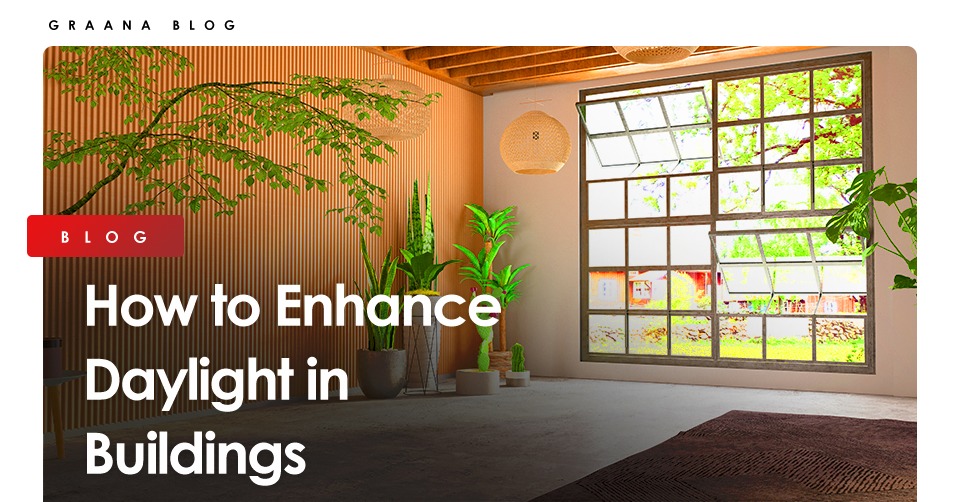Daylight is an important component of our daily lives. It is advocated as the best substitute for artificial lighting thus ensuring resource conservation at major levels. Since, fossil fuels are still a primary source of generating electricity, channelising the sunlight at day times to some extent can help to reduce the consumption of fossil fuels. One problem that is common across developing countries is energy short-fall. To meet the consumer demands various substitutes are explored so that businesses and industries keep on running. Therefore, many developing states over time have issued advisories for the optimum use of daylight.
Graana.com through this blog elaborates the different ways which can be adapted to utilise the maximum daylight in residences or commercial centres.
Advantages of Daylight
Exposure to daylight has numerous advantages. Foremost among many is the cost-saving; channelising sunlight inside the buildings can save financial resources of a family or an organisation alike. In a study sponsored by the US Department of Energy, it was highlighted that one of the factors that an organisation considers before leasing or constructing a building is the cost analysis. Therefore, an organisation can consider the aspect of daylight and its cost-effectiveness.
Furthermore, daylight also has a relation with human productivity. It has been noted that lighting is an important factor in maintaining the circadian system of humans. The circadian system is the natural cycle inside humans which is about maintaining natural-human processes. The sleep-wake cycle is one of the important processes of the circadian system.
Similarly, the impact of daylight also has a positive mood on human psychology. That’s why windows are preferred at workspaces for channelling the sunlight inside the buildings. It is observed that daylight has a positive impact on the productivity of employees if it does not interfere with visuals and the temperature of the surroundings. Windows that allow the outside view and do not let the radiation inside are demanded by most consumers.
Following are the different methods through which daylight can be channelised inside houses for enhanced visuals and increasing human productivity.
Light Tubes
Light tubes or sun tubes are the common tools that are used to channelise the sunlight inside homes. These tubes can prove beneficial in those areas where sunlight is obstructed due to congested spaces, or non-alignment of windows to the sunlight. Light tubes reflect the sunlight inside the dwellings to illuminate spaces. The light tubes have an opening which helps to catch the sunlight, and highly reflective materials help to channelise the light inside buildings.
The benefits of light tubes are that it is cost-effective and can be installed easily without paying a hefty amount. In the 2012 London Olympics, light tubes were installed in the Copper Box arena to reduce energy use.
Prism Panels
Prism panels were popular in buildings in the 18th century, these panels have started to gain popularity recently with advanced techniques. A prism panel has to be tailored according to the window adjustment while keeping in view the angle of sun rays. Prism panels disperse and channel the skylight or sunlight inside the buildings thus becoming a forerunner to optimum use of daylight. Prisms are one of the common tools used in ship decks to refract the sunlight in ship decks. Therefore, prims can be a cost-effective tool for managing sunlight indoors. Some windows are already equipped with prism panels thus making it convenient to install the windows at the time of construction.
Paying Attention to Color Scheme
Colour schemes inside a home tend to play a major role in the management of daylight. Certain colours absorb the light while certain colours reflect the light. It is recommended that white colour should be used inside the buildings since it reflects the light. Therefore, rooms or buildings that don’t get enough sunlight can use a light colour for enhancing the sunlight. White is a preferred colour where the sunlight cannot reach directly. Similarly, white furniture is also preferred in the rooms since it also helps to enhance the daylight in rooms.
Skylight
Certain buildings affix metallic structures in roofs to make room for the sunlight. This method is useful in those buildings where the sunlight cannot enter from the sides of the buildings. Therefore, skylights allow the sunlight to enter the building structures from the top. The use of skylights dates back to ancient times and was a prominent part of Roman Architecture. With advancements in architecture and design, skylights are still an important medium for managing daylight.
Using Reflective Materials
There are certain components in homes that can be replaced with reflective materials to enhance the daylight. It is recommended that reflecting glass tiles in washrooms and kitchens should be used so that light can be reflected from the surface. Similarly, glossy paints are also recommended for increasing the daylight since they also have a reflective property that enhances the daylight in buildings.




